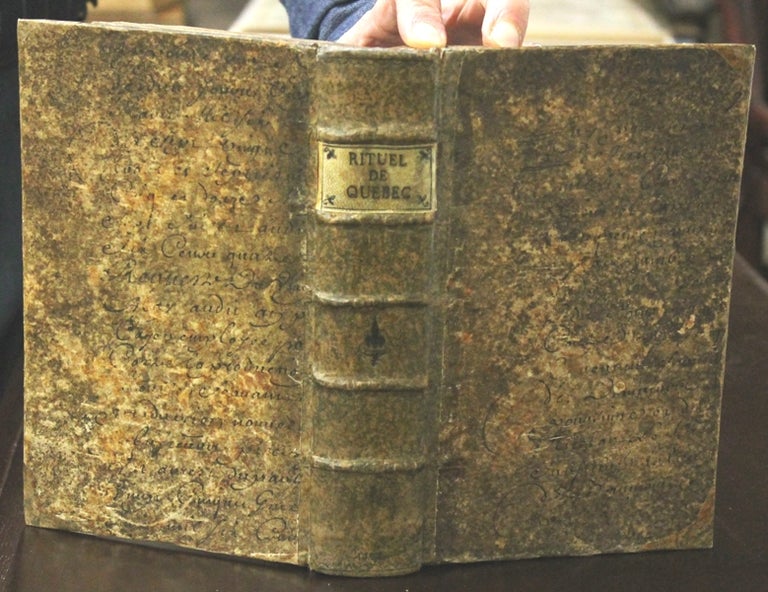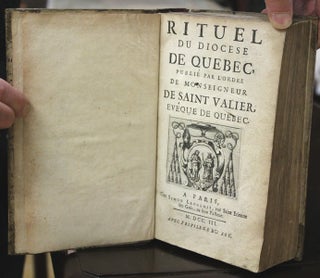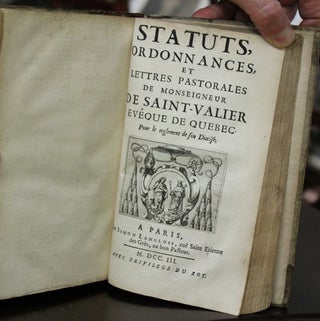RITUEL// DU DIOCESE // DE QUEBEC, // PUBLIÉ PAR L’ORDRE // DE MONSEIGNEUR // DE SAINT-VALIER, // EVEQUE DE QUEBEC. // A PARIS, // Chez SIMON LANGLOIS, rue Saint Etienne // des Grès, au bon Pasteur. // M. DCC.III // AVEC PRIVILEGE DU ROY.
Bound with
Statuts, // ordonnances, // et // lettres pastorales // de Monseigneur // de Saint-Valier // evêque de Quebec. // Pour le règlement de son Diocèse. // A Paris, // Chez Simon Langlois, ruë Saint Etienne // des Grès, // au bon Pasteur. // M.DCC.III. // Avec privïlege du Roy.
Paris: Chez Simon Langlois, c. 1703, Edition: First Editions, Binding: Contemporary full paper boards, expertly rebacked; raised spine with five (5) bands, black ink title on vellum label on two; central black fleur de lis design on four. , Notes: Text in French; with some text in Latin.
The present work describing festivals, sacraments, statutes and ordinances for the use by priests, is extremely rare and was immediately followed by a second edition published the same year: Gagnon reports that in a copy of the second edition of 1703, now at the Laval University library and previously owned by Abbé Plante, a note says that the first edition “would have been almost completely destroyed by the sinking of the ship …carrying it to Canada, and for this reason, a second edition was immediately made.”
On the “privilege”, included as the final leaf in our first edition example, it is stated that the work was registered on March 30, 1703 and completed for print for the first time on March 31, 1703;
Saint-Valier was a supporter of the Counter Reformation. His initial intent in the New World was to engage in the conversion of the indigenous residents. He introduced Jesuits and Recollects in an attempt to evangelize New France. Many of these missions (Illinois, Louisiana, and Mississippi) resulted in conflicts between Bishop Saint-Vallier, the Jesuits and the seminary of Quebec.
His various construction projects reflect a desire to restore and renew the authority in the Catholic Church as the main institution of administrative organization. In 1697, Saint-Valier built a palace in Quebec for his clergy and as a place of hospitality. During the same year, he also established a nuns monastery in Trois-Rivières Saint-Vallier’s zeal for religious activities and establishments, stretched from Quebec, Montreal, Acadia and Louisiana. His way of life embodied that of the ideals of the Council of Trent.
The Diocese of Quebec was vast and its population diverse and widespread. It included the whole of French North America, or what was called New France, divided in seven colonies: Newfoundland, Acadia, Île Royale, Louisiana, Illinois, Upper Country and Canada, inhabited by Indigenous people and the European settlers. During the tenure of Saint-Vallier, immigration from France was mostly over; the European colonists were farmers, fishermen, sailors, merchants and ‘coureurs des bois’, overseen by a small elite of aristocratic leaders, but a great demographic explosion occurred between 1685 and 1730, the white population in New France jumping from c. 12,000 inhabitants to c. 41,500.
During the same time, the number of Amerindian fell from c. 163,500 to c. 61,500. That loss, mainly in the tribes of Louisiana, was attributed to warfare and diseases brought to the valley of the Mississippi. The number of Aboriginals compared to white settlers is one reason for the presence of so many religious orders in New France. The missions and conversions to Christianity were deemed very important.
Priests of the Missions Étrangères of Paris, the Jesuits, the Recollets and the Sulpicians often worked in collaboration with the nuns from different orders like the Congrégation de Notre-Dame or the Canonesses of St. Augustine of the Mercy of Jesus at l’Hôtel-Dieu de Québec. The arrival of Saint-Vallier and his strong views on what should be the duties of the priests created a shock wave in the orders, especially for the Seminary of Quebec, newly founded by his predecessor Bishop Laval. … Saint-Vallier's tenure as bishop was defined by interminable quarrels with governmental and religious institutions in French North America. … his active leadership style brought him into conflict with various groups, who perceived him as, at times, domineering and micromanaging.
While subject to much criticism, Saint-Vallier was also admired in his diocese for his dedication and self-sacrifice. Rather than staying in Quebec or Montreal, he tirelessly traveled the back-country. The founding of the Hôpital Général and installation of Jesuits and Recollets at Montreal were also to his credit.
There was a very strong suspicion in the colonies and in France that the Bishop of Quebec was in fact a follower of Jansenism. ... In the beginning of the 18th century the Bishop wrote 3 books; the Ritual, the Catechism and the ‘Statuts et ordonnances’ – two of which are bound in the present volume.
…the Superior of the jesuite order decided to attack Saint-Vallier’s authority by writing a long critic of those three books seeing them as a "lapse into Arianism, Pelagianism, Jansenism, Lutheranism, and Calvinism". Father Bouvart based his accusations on different passages of the works of the Bishop, … who eventually appealed to the Sorbonne to have his works rehabilitated. The doctors of the Faculty of Theology declared the Ritual and the Catechism perfectly orthodox and censured the critic of Bouvart. Nevertheless, Saint-Vallier decided to re-edit in 1713 the Ritual so as to cast away all doubts about his pretended Jansenist ideas. This book remained in use in the parishes until the middle of the 19th century. The present work is the unedited original and first edition of his ritual and statuts.
The disputes with the religious orders of New France, the government and the merchants gave way to a more peaceful period that lasted until his death... Austere throughout his life, he became more and more humble in his way of living and turned toward contemplation and simple duties. ...He also took very seriously his duties of Bishop and developed parishes in the farthest corners of the diocese.
[Achevé d'imprimer pour la premiere fois, ce 31 mars 1703. Relié avec le Rituel du même.] , Size: Octavo (213 x133mm)., Illustration: Illustrated with two printer's devices representing the arms of the archdiocese of Quebec; various head and tail pieces, incl. vignettes; in-text music notes on Qiiii-Si; Ggii-iiii.
, Provenance: Upper pasted endpaper with owner’s armorial bookplate: “Watkin Williams Esq of Penbedw // in the county of Denbigh”. Concerning this name, Archaeologia Cambrensis states: “1789. Watkin Williams, Esq., of Penbedw, in the county of Denbigh, (but owner of pr, References: Philéas Gagnon: Essai de bibliographie canadienne: Inventaire d'une bibliothèque ..., Volume 1: 3138 & 3139, p.437; Archaeologia Cambrensis, Volume 1, p.142., Pages: Ff. 2 bl., ill. title, bl., author to priests on the use of the book (4), Fetes Observe’es (4), 604, table (2), errata (3), bl.; ill. title, bl., letter (3), 8-146, table (2), privilege (2), [bl.2]; In leaf collation: [bl.], [v], A-Z8, Aa-Nn8, Oo-Rr4, [iiiff. table]; [a1], a3-a8, e8, i8, o8, u8, aa8, ee8, ii2, oo8, uu8, aaa1, [ii], [bl.]. , Category: Book Canada; Book Religious Christianity; Book Europe France;. near fine with text clean and crisp. Item #B6045
Edition: First Editions, Binding: Contemporary full paper boards, expertly rebacked; raised spine with five (5) bands, black ink title on vellum label on two; central black fleur de lis design on four. , Notes: Text in French; with some text in Latin.
The present work describing festivals, sacraments, statutes and ordinances for the use by priests, is extremely rare and was immediately followed by a second edition published the same year: Gagnon reports that in a copy of the second edition of 1703, now at the Laval University library and previously owned by Abbé Plante, a note says that the first edition “would have been almost completely destroyed by the sinking of the ship …carrying it to Canada, and for this reason, a second edition was immediately made.”
On the “privilege”, included as the final leaf in our first edition example, it is stated that the work was registered on March 30, 1703 and completed for print for the first time on March 31, 1703;
Saint-Valier was a supporter of the Counter Reformation. His initial intent in the New World was to engage in the conversion of the indigenous residents. He introduced Jesuits and Recollects in an attempt to evangelize New France. Many of these missions (Illinois, Louisiana, and Mississippi) resulted in conflicts between Bishop Saint-Vallier, the Jesuits and the seminary of Quebec.
His various construction projects reflect a desire to restore and renew the authority in the Catholic Church as the main institution of administrative organization. In 1697, Saint-Valier built a palace in Quebec for his clergy and as a place of hospitality. During the same year, he also established a nuns monastery in Trois-Rivières Saint-Vallier’s zeal for religious activities and establishments, stretched from Quebec, Montreal, Acadia and Louisiana. His way of life embodied that of the ideals of the Council of Trent.
The Diocese of Quebec was vast and its population diverse and widespread. It included the whole of French North America, or what was called New France, divided in seven colonies: Newfoundland, Acadia, Île Royale, Louisiana, Illinois, Upper Country and Canada, inhabited by Indigenous people and the European settlers. During the tenure of Saint-Vallier, immigration from France was mostly over; the European colonists were farmers, fishermen, sailors, merchants and ‘coureurs des bois’, overseen by a small elite of aristocratic leaders, but a great demographic explosion occurred between 1685 and 1730, the white population in New France jumping from c. 12,000 inhabitants to c. 41,500.
During the same time, the number of Amerindian fell from c. 163,500 to c. 61,500. That loss, mainly in the tribes of Louisiana, was attributed to warfare and diseases brought to the valley of the Mississippi. The number of Aboriginals compared to white settlers is one reason for the presence of so many religious orders in New France. The missions and conversions to Christianity were deemed very important.
Priests of the Missions Étrangères of Paris, the Jesuits, the Recollets and the Sulpicians often worked in collaboration with the nuns from different orders like the Congrégation de Notre-Dame or the Canonesses of St. Augustine of the Mercy of Jesus at l’Hôtel-Dieu de Québec. The arrival of Saint-Vallier and his strong views on what should be the duties of the priests created a shock wave in the orders, especially for the Seminary of Quebec, newly founded by his predecessor Bishop Laval. … Saint-Vallier's tenure as bishop was defined by interminable quarrels with governmental and religious institutions in French North America. … his active leadership style brought him into conflict with various groups, who perceived him as, at times, domineering and micromanaging.
While subject to much criticism, Saint-Vallier was also admired in his diocese for his dedication and self-sacrifice. Rather than staying in Quebec or Montreal, he tirelessly traveled the back-country. The founding of the Hôpital Général and installation of Jesuits and Recollets at Montreal were also to his credit.
There was a very strong suspicion in the colonies and in France that the Bishop of Quebec was in fact a follower of Jansenism. ... In the beginning of the 18th century the Bishop wrote 3 books; the Ritual, the Catechism and the ‘Statuts et ordonnances’ – two of which are bound in the present volume.
…the Superior of the jesuite order decided to attack Saint-Vallier’s authority by writing a long critic of those three books seeing them as a "lapse into Arianism, Pelagianism, Jansenism, Lutheranism, and Calvinism". Father Bouvart based his accusations on different passages of the works of the Bishop, … who eventually appealed to the Sorbonne to have his works rehabilitated. The doctors of the Faculty of Theology declared the Ritual and the Catechism perfectly orthodox and censured the critic of Bouvart. Nevertheless, Saint-Vallier decided to re-edit in 1713 the Ritual so as to cast away all doubts about his pretended Jansenist ideas. This book remained in use in the parishes until the middle of the 19th century. The present work is the unedited original and first edition of his ritual and statuts.
The disputes with the religious orders of New France, the government and the merchants gave way to a more peaceful period that lasted until his death... Austere throughout his life, he became more and more humble in his way of living and turned toward contemplation and simple duties. ...He also took very seriously his duties of Bishop and developed parishes in the farthest corners of the diocese.
[Achevé d'imprimer pour la premiere fois, ce 31 mars 1703. Relié avec le Rituel du même.] , Size: Octavo (213 x133mm)., Illustration: Illustrated with two printer's devices representing the arms of the archdiocese of Quebec; various head and tail pieces, incl. vignettes; in-text music notes on Qiiii-Si; Ggii-iiii.
, Provenance: Upper pasted endpaper with owner’s armorial bookplate: “Watkin Williams Esq of Penbedw // in the county of Denbigh”. Concerning this name, Archaeologia Cambrensis states: “1789. Watkin Williams, Esq., of Penbedw, in the county of Denbigh, (but owner of pr, References: Philéas Gagnon: Essai de bibliographie canadienne: Inventaire d'une bibliothèque ..., Volume 1: 3138 & 3139, p.437; Archaeologia Cambrensis, Volume 1, p.142., Pages: Ff. 2 bl., ill. title, bl., author to priests on the use of the book (4), Fetes Observe’es (4), 604, table (2), errata (3), bl.; ill. title, bl., letter (3), 8-146, table (2), privilege (2), [bl.2]; In leaf collation: [bl.], [v], A-Z8, Aa-Nn8, Oo-Rr4, [iiiff. table]; [a1], a3-a8, e8, i8, o8, u8, aa8, ee8, ii2, oo8, uu8, aaa1, [ii], [bl.]. , Category: Book Canada; Book Religious Christianity; Book Europe France;.
Price: $7,500.00



